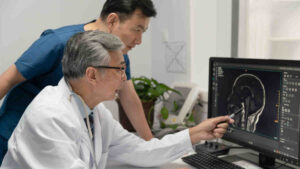Dr Boreham’s Crucible: Is Universal Biosensors really the ‘Tesla or Apple’ of handheld detection?

Pic: Charnchai / iStock / Getty Images Plus via Getty Images
Almost a year into his reign at the sensor monitoring group, Universal Biosensors (ASX:UBI) chief John Sharman doesn’t hold back about the company’s ability to disappoint investors over the last decade, despite big-ticket deals with industry giants Johnson & Johnson (Lifescan) and Siemens.
His blunt assessment: “I’ve seen plenty of corporate disasters over my journey, but none with such great technology and opportunity that has delivered almost nothing.”
Ouch!
Whether this critique is totally fair or not, clear evidence is emerging of an uptick in fortunes under the reign of Sharman, who ran fellow ASX-listed device play Medical Developments for a decade.
When he clocked on, Universal derived most of its (modest) revenue from providing its Xprecia Stride blood coagulation monitoring strips to Siemens (for warfarin users).
In September 2019, the company bought back the coagulation rights from Siemens, for $15 million.
In September 2018, Lifescan exercised its option to buy the rights to Universal’s blood glucose monitoring platform for $44.6 million, a disappointing deal that sent the share-price crashing.
Using its core electrochemical platform, Universal has now launched a potentially lucrative wine testing device and is also confident of a simple test for cancer biomarkers, hormones (for fertility testing) and veterinary glucose testing.
The back story
The Universal story is based on its proprietary handheld electro-chemical sensing system, devised by a team led by CSIRO electro-chemist Dr Alistair Hodges.
Universal Biosensors listed in December 2006 after raising $22 million at 50 cents apiece. For reasons lost in the mists of time, the company is incorporated in Joe Biden’s home state of Delaware but is not listed in the US.
Still, the company has to file all those ponderous Securities and Exchange Commission disclosures that use archaic fonts and terminology and go on for pages and pages … and pages.
Similar to the cartridge and printer model, the company derived annuity revenue from both the hand-held device (the printer) and the single use disposable strips.
Ten billion blood and coagulation tests have been carried out, so there’s no issue with the tech being verified.
Sharman was CEO of Medical Developments for 10 years, having previously run the nuclear imaging company Cyclopharm.
He became involved with Universal Biosensors via Max Johnston, who was president of Johnson & Johnson’s Asia Pacific operations and a Medical Developments director.
“He was the one signing the cheques and liked the technology,” Sharman says.
From micromolar to picomolar
Sharman says the platform’s applications have been limited to so-called micromolar level detection, which rules out many health applications.
In a deal with Lubris Biopharma, the company has secured technology that increases detection by one million times, to picomolar level.
The secret sauce is an anti-fouling agent called Lubricin, which Sharman describes as a “supersonic magnifying glass”.
When applied to electro-chemicals in bio-assays, the coating overcomes the issue of electrode surface fouling. The upshot is that the company can expand into the oncology, women’s health and wine testing applications.
Sharman says the ensuing clarity is like comparing the functionality of an old camera to that of a mobile phone.
“Lubricin makes us the Tesla or Apple versus Kodak. It puts us at the forefront of handheld detection.”
Early cancer detection with a pin prick
In the cancer space, Universal is targeting a test for the Tn antigen, which is expressed in at least 10 carcinomas including breast lung, prostate, bladder and colorectal.
Developed in conjunction with Swinburne, Deakin and Wollongong universities, the sensor detects the early warning sign of a carcinoma.
Apart from early diagnosis, Sharman says the simple test has the potential as a tool for physicians to test the progression of cancer from stage one to stage three.
It can also map the efficacy of a therapy.
Perhaps the most promising use is as an easy ongoing home test for cancer patients in remission.
Sharman says a typical regimen currently is twice-yearly tests for the first two years, and then one test annually, thereafter.
A Universal Biosensors Tn test could be carried out weekly, increasing the chances of early detections of recurring carcinomas.
Sharman notes that 131 million cancer patients are in remission, with 78 million of these recovering from carcinomas.
With 122 million blood cell count tests done each year, the remission market alone is worth $17 billion a year.
According to one study, 90 per cent of patients with recurring bladder cancer had detectable levels of Tn antigen.
Sharman acknowledges that while the regulatory pathway would be similar to that pursued for the blood and coagulation monitoring, the hurdles are not to be sneezed at.
A fertile source of revenue
For the purpose of fertility procedures, the patient’s oestrogen and progesterone levels have to be just right to maximise the chances of procreation.
The two million patients undergoing in-vitro fertilization (IVF) procedures a year need to undergo half a dozen ‘blood draw’ tests to determine the optimal levels of the blood tests.
“That’s a $2 billion a year industry just for the blood tests,” Sharman says.
The company is being advised by Prof Michael Cooper, a leading Australian fertility expert.
I’ll drink to that
Universal’s clear and present revenue opportunity lies not with human health but human happiness: testing wine batches during production.
While winemakers pride themselves on their artisan abilities, the truth is that the process involves more chemistry than a petro-chemical plant.
“The artists hate the chemistry but need it to create the art,” Sharman says. “The winemaker doesn’t want to be a chemist, but the chemist wants to be a winemaker.”
Vignerons need to test separately for levels of free sulphur, malic acid, glucose and fructose, acetic acids and total acids.
Universal Biosensors is already marketing its device, Sentia, to test for sulphur levels and hopes to expand to four tests by the end of 2020.
Traditionally, each assay takes 20 to 30 minutes, with the testers scurrying between barrel barn and lab to test and manually record each batch.
“We will do it inside a minute, in an idiot-proof fashion,” Sharman says.
Indeed, Sharman kindly whipped out his kit and uncapped a minibar sized bottle of Jacobs Creek cab sav, to demonstrate that that’s indeed the case.
Crucially, the test can be carried out for one-tenth (or perhaps even one-twentieth) of the cost of the current tests, which involve beakers and other paraphernalia.
Having launched Sentia in early March, Universal claims sales of 800 devices and 100,000 strips, which “in a Covid-infected world is a very good result”.
Having secured a string of country-based distribution deals, the company cites access to 14,000 winemakers. The devices sell for just under $2,000, with a per-strip cost of $3.50.
With more 100 million tests carried out each year, the wine testing market turns over $US850 million ($1.1 billion) annually.
“Getting to somewhere between 15 per cent and 30 per cent [market share] feels right, but we could get to 40 per cent,” Sharman says.
The company is using the Coldstream Hills winery, formerly owned by wine critic James Halliday and now in the hands of Treasury Wine Estates, as a test site.
During harvest and bottling time, the Yarra Valley winery has to hire a person for six weeks carry out 1,400 sulphur tests across 40 bins (barrels).
Don’t forget the animals
Another promising sideline is with the veterinary market for glucose (diabetes) testing.
The story here is that while Lifescan bought the human glucose testing business, it has no interest in the cats-and-dogs side and was happy to cede the tech to the company.
The vet glucose testing market is worth $200 million and growing around 11 per cent a year.
The key driver? An astonishing 50 per cent of US companion dogs are obese and – yes – they resemble their owners.
Sharman notes the market is already serviced by two key providers, but they have clunky products.
If Universal can penetrate 10 per cent of the market, that’s $20 million of annual revenue.
“We are just going to come to market with a cheaper, faster, better mouse trap,” he says.
“The company has just got to get the tech back and dust off the cobwebs. Some tinkering needs to be done to the meter and to the algorithms to accommodate for dogs and cats rather than humans.”
The company expects to launch the vet product by the end of 2022.
Financials and performance
Universal Biosensors recorded revenue of just over $1.5 million in the March quarter of 2021, with turnover derived mainly from coagulation testing with a splash of wine as well.
In the year to December 2020 the company turned over $3.2 million, down 54 per cent and lost $7.6 million compared with a $4.8 million shortfall previously.
Sharman says the company is “working hard” to achieve consistent monthly breakeven by the June half of 2022.
Thanks to the Johnson & Johnson Lifescan deal, Universal Biosensors has $24 million of cash. It also has no debt, having repaid an (expensive) $15 million loan to Athyrium Opportunities Fund in late 2018.
Ostensibly, there’s no good reason for the company to be US-incorporated – it’s more trouble than it’s worth – but with $US25 million tax losses crystallised in the corporate structure the arrangement won’t unwind in a hurry.
(For all intents and purposes the company is headquartered in the Melbourne suburb of Rowville, where it makes the strips.)
Over time, Universal Biosensors shares have traded between a peak of $2.00 in January and a low of 14 cents in mid-March last year.
For a while, the shares traded well below net cash backing ascribing a negative value to the company’s technologies.
stockname share price today:
Dr Boreham’s diagnosis:
Universal Biosensors’ headline ambition is to have between 10 and 12 sensors on market, including six in wine and three in fertility.
And with coagulation back in its own hands, the company is confident of increasing overall revenue to $20 million a year.
The way we see it is that wine testing will uncork handy short-term revenues, while the cancer testing offers the most capacious upside.
On the vino side, winemakers tend to stick to tradition even though their way of doing things might not be the most effective. But most of them fell out of love with the romance of cork when Stelvin closures (screw caps) proved to be far more effective at preventing wine spoilage.
While Sharman was at Medical Developments, the company increased market valuation from $7 million to up-to $770 million.
“Universal Biosensors has the potential to outstrip that, if we get it right,” he says.
Firstly, though, management needs to re-engage with jaded shareholders. But the stock’s circa 300 per cent bounce over the last year shows they are starting to groove to the jungle drums of opportunity.
Disclosure: Dr Boreham is not a qualified medical practitioner and does not possess a doctorate of any sort. He didn’t drink the remaining Jacobs Creek because it was (a) Jacobs Creek and (b) 10 am, not 11am.
This column first appeared in Biotech Daily.
UNLOCK INSIGHTS
Discover the untold stories of emerging ASX stocks.
Daily news and expert analysis, it's free to subscribe.
By proceeding, you confirm you understand that we handle personal information in accordance with our Privacy Policy.








